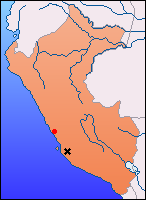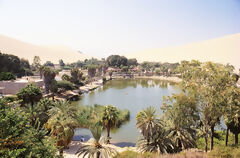 |
Associated pages: |
 The region of Ica has been inhabited since ancient times, particularly between 2500 BC and 1400 AD, by civilizations such as the Paracas and Nazca cultures. These ancient peoples managed to solve the challenge of irrigating desert lands by developing complex underground canal systems known as "puquios," which allowed the irrigation of arid areas, enabling agriculture in a region with an extremely dry climate. In addition to their ability to master the desert landscape, these cultures excelled in goldsmithing, textile arts, and pottery, producing some of the finest artifacts that have been preserved to this day.
The region of Ica has been inhabited since ancient times, particularly between 2500 BC and 1400 AD, by civilizations such as the Paracas and Nazca cultures. These ancient peoples managed to solve the challenge of irrigating desert lands by developing complex underground canal systems known as "puquios," which allowed the irrigation of arid areas, enabling agriculture in a region with an extremely dry climate. In addition to their ability to master the desert landscape, these cultures excelled in goldsmithing, textile arts, and pottery, producing some of the finest artifacts that have been preserved to this day.
The Paracas were particularly known for their textiles, famous for their vibrant colors and complex geometric patterns, while the Nazca excelled in creating polychrome ceramics and, of course, the enigmatic Nazca lines, whose meanings are still the subject of research and debate. Beyond their artistic prowess, these cultures demonstrated a deep understanding of astronomy, using their observations of the skies to guide both their religious ceremonies and agricultural activities.
Later, during the expansion of the Inca Empire, under the leadership of Inca Pachacutec, the Paracas and Nazca cultures were annexed into the empire, which facilitated cultural and economic exchange between these regions and the rest of the empire. The Incas, known for their agricultural terraces and irrigation systems, expanded and improved the infrastructure already present in the Ica region, integrating the local communities into their vast trade network.
In the colonial period, after the arrival of the Spaniards, the region became an important agricultural and viticulture center. On June 17, 1563, Don Luis Jerónimo de Cabrera founded the Villa de Valverde de Ica. However, due to issues with its original location, the city was moved and renamed San Jerónimo de Ica. During the colonial era, the production of wine and Pisco became one of the region’s main economic activities, and to this day, Ica is known as the birthplace of Pisco, the famous Peruvian brandy.
One of the most significant events of the Republican era took place in the Plaza de Armas of Ica on October 20, 1820. That day, Juan José Salas, then mayor of Ica, proclaimed the independence of Peru, marking a pivotal moment in the country's history. This act of rebellion against Spanish colonial rule was one of the first calls for liberation in southern Peru, igniting patriotic fervor throughout the region.
During the Republican era, Ica became a key economic center, not only because of its agricultural production but also due to its growing tourism industry. The region is known for its warm and sunny climate year-round, making it an ideal destination for sun and adventure lovers.
Today, Ica offers a wide range of activities for visitors, from exploring its vast countryside to embarking on desert adventures in its impressive sand dunes, some of the most spectacular in Peru. The Ica desert is famous for its massive dunes, which are the perfect setting for extreme sports like sandboarding and dune buggy rides. Gliding down these immense sand mountains is one of the most thrilling activities Ica has to offer for adventure seekers.
One of the most famous natural jewels in the region is the Huacachina oasis, a small green paradise in the middle of the desert, surrounded by palm trees and giant dunes. According to local legend, the oasis was formed when an Inca princess, caught while bathing, left behind a pool of water that turned into the lake we know today. Huacachina is the perfect place to relax after a day of desert adventures and offers a unique setting for boat rides and hikes through the surrounding dunes.
Additionally, Ica is the ideal starting point for visiting other iconic sites in the region, such as the Nazca Lines, which are located nearby. These gigantic figures etched into the desert remain a mystery, attracting researchers and tourists from around the world. Close to Ica is also the Paracas National Reserve, an impressive protected area that is home to a great diversity of marine wildlife, including sea lions, Humboldt penguins, and various species of migratory birds.
Ica is also an important cultural and religious center. The city celebrates various festivals throughout the year, the most famous being the Fiesta de la Vendimia, a celebration in honor of the grape harvest and Pisco production, featuring parades, competitions, and the traditional grape stomping. Semana Santa (Holy Week) is another highlight on the local calendar, when the city fills with religious processions and activities that attract visitors from all over the country.
With its rich history, vibrant culture, and stunning landscapes, Ica is a must-visit destination for those looking to experience the best of the Peruvian desert, combining adventure, history, and relaxation in one incredible place.